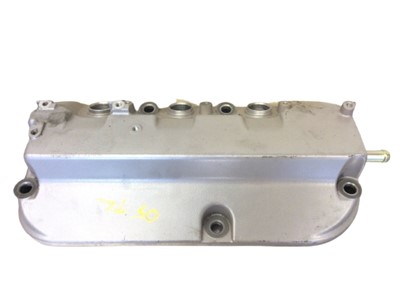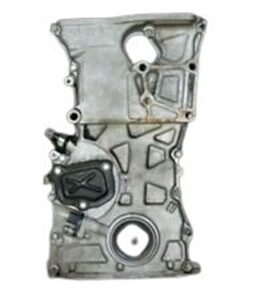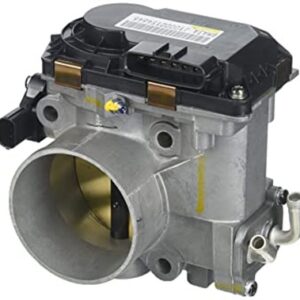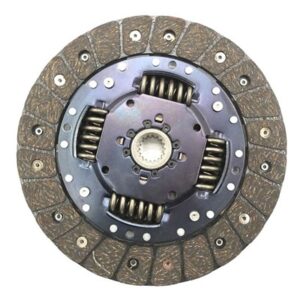Engine Cylinder Valve Cover
The valve cover, also known as a rocker cover, is a vital component of any engine, whether it’s made of durable plastic or robust metal.
Expertly engineered, this cover securely bolts onto the top of the cylinder head, playing a crucial role in maintaining optimal engine performance.
Crafted for precision, it acts as a safeguard, preventing oil leakage from the cylinder heads while effectively shielding them from debris and contaminants.
Designed with meticulous attention to detail, our valve cover ensures a seamless fit and reliable protection for your engine’s critical components.
Engineered for longevity and performance, it serves as a testament to our commitment to quality.
Trust in the durability and functionality of our valve cover, as we prioritize the integrity of your engine’s cylinders.
Upgrade your vehicle with the assurance that our valve cover provides, embodying excellence in both design and functionality.
$92.00
CompareEngine Cylinder Valve Cover
The engine cylinder valve cover, commonly referred to as a valve cover or rocker cover, is an essential component of an internal combustion engine. Positioned at the top of the engine, it serves to protect the engine’s valve train components, maintain oil containment, and contribute to the overall engine aesthetic. Typically constructed from durable materials, the valve cover plays a crucial role in engine performance, efficiency, and maintenance.
Material and Construction
Valve covers are designed to withstand the harsh conditions of an engine environment, including high temperatures, oil exposure, and vibration:
- Aluminum: Many modern Engine Cylinder valve covers are made from aluminum due to their lightweight nature, heat resistance, and ability to be cast into complex shapes. Aluminum valve covers are common in performance-oriented and high-end vehicles.
- Plastic/Composite: Some Engine Cylinder valve covers are made from high-strength plastics or composite materials, offering cost-effective manufacturing, weight reduction, and good resistance to oil and chemicals. These are commonly used in contemporary passenger vehicles.
- Steel: Traditional valve covers are often made from stamped steel, which provides robustness and durability. Steel valve covers are still widely used, particularly in older or heavy-duty engines.
- Magnesium and Carbon Fiber: In high-performance and racing applications, valve covers may be made from magnesium or carbon fiber to further reduce weight and enhance thermal efficiency.
Design and Functionality
The Engine Cylinder valve cover is engineered with specific features to perform its critical roles in the engine:
- Sealing and Oil Containment: The Engine Cylinder valve cover is fitted with a gasket, usually made of rubber or cork, to create a tight seal between the cover and the engine cylinder head. This seal prevents engine oil from leaking out and contaminants from entering the engine.
- Protection of Valve Train Components: The Engine Cylinder valve cover shields the valve train components, such as the rocker arms, camshafts, and valve springs, from dirt, debris, and other contaminants. This protection is crucial for maintaining the longevity and performance of these components.
- Oil Splash and Ventilation: The interior design of the valve cover helps direct and control the flow of oil as it lubricates the valve train components. Additionally, many valve covers include ventilation ports or PCV (Positive Crankcase Ventilation) valves to allow gases to escape from the crankcase, reducing pressure buildup and preventing oil leaks.
- Mounting Points: Engine Cylinder Valve covers often have integrated mounting points for sensors, ignition coils, and other engine accessories, providing a secure location for these components.
Types of Engine Cylinder Valve Covers
Various types of valve covers are designed to meet the specific needs of different engine configurations and applications:
- Standard Valve Covers: These are basic covers designed to fit most standard engine configurations. They provide essential protection and oil containment without additional features.
- Performance Valve Covers: These covers are designed for high-performance engines and may include features like increased height to accommodate high-lift camshafts, baffling to improve oil control, and provisions for additional breather ports or PCV valves.
- Decorative Valve Covers: Some valve covers are designed with aesthetic enhancements, such as polished finishes, engraved logos, or custom paint. These covers are popular in show cars and customized vehicles, where engine appearance is a priority.
- Custom and Aftermarket Valve Covers: Aftermarket valve covers offer various customization options, including different materials, finishes, and shapes. These covers allow enthusiasts to personalize their engine bay and improve performance features such as oil control and ventilation.
Performance and Benefits
Valve covers play a crucial role in maintaining engine performance and reliability:
- Oil Leak Prevention: A properly sealed valve cover with a quality gasket prevents oil leaks, which can lead to oil consumption, engine misfires, and potential damage to electrical components.
- Contaminant Protection: By sealing the top of the engine, valve covers protect sensitive valve train components from dirt, dust, and other debris that can cause wear and tear.
- Aesthetic Enhancement: Valve covers contribute to the overall look of the engine bay. Custom valve covers can enhance the appearance of performance engines, making them visually appealing.
- Heat Dissipation: In some cases, especially with aluminum or magnesium valve covers, the material aids in dissipating heat from the engine, contributing to better thermal management.
Maintenance and Care
Regular inspection and maintenance of the valve cover are essential to ensure its proper functioning:
- Check for Leaks: Periodically inspect the area around the valve cover for signs of oil leaks. Oil stains or wetness around the gasket area may indicate a failing gasket or improperly secured valve cover.
- Gasket Replacement: Over time, valve cover gaskets can become brittle or damaged, leading to leaks. Replace the gasket at recommended service intervals or whenever a leak is detected.
- Tightening Bolts: Ensure that the valve cover bolts are properly torqued to the manufacturer’s specifications. Over-tightening can damage the gasket or cover while under-tightening can lead to leaks.
- Cleaning: Keep the valve cover and surrounding area clean to prevent the buildup of dirt and grime. Regular cleaning helps maintain the appearance and can make it easier to detect leaks or other issues.
Advanced Features and Technologies
Some modern valve covers incorporate advanced features to enhance their functionality:
- Integrated PCV Systems: Many valve covers include integrated PCV (Positive Crankcase Ventilation) systems that help manage crankcase pressure and reduce emissions. These systems improve engine efficiency and performance.
- Noise Reduction Features: Some valve covers are designed with sound-dampening materials or structures to reduce engine noise, contributing to a quieter cabin environment.
- Enhanced Oil Control Baffles: Performance valve covers often feature advanced baffling designs to improve oil control, especially in high-performance engines subject to extreme conditions.
- Sensor Integration: Advanced valve covers may have built-in sensors for monitoring oil pressure, temperature, or other critical parameters, providing real-time data to the engine management system.
Conclusion
The engine cylinder valve cover is more than just a protective shield for the valve train; it plays a vital role in maintaining the engine’s performance, reliability, and appearance. By understanding the construction, functionality, and maintenance requirements of valve covers, vehicle owners can ensure their engines operate smoothly and efficiently. Whether for standard use or high-performance applications, valve covers are essential components that contribute significantly to the overall health and performance of the engine.
Based on 0 reviews
Be the first to review “Engine Cylinder Valve Cover” Cancel reply
Related products
-
Engine
Timing Cover
0 out of 5(0)The timing cover stands as a crucial safeguard for your vehicle’s internal components, shielding the timing belt, timing chain, or cam belt from the hazards of road debris and contaminants.
Positioned prominently at the engine’s forefront, this meticulously crafted cover ensures the optimal performance of your car’s internal combustion engine.
Engineered to withstand the rigours of the road, it is an indispensable component for maintaining the precise rotation of camshafts and the crankshaft.
Crafted with precision and durability in mind, our timing cover is meticulously designed to protect vital engine elements, promoting longevity and efficiency.
Whether it’s a Harley, SBC, LS, or BBC, our versatile timing cover is compatible across various brands, ensuring seamless integration.
Elevate your vehicle’s performance with our top-tier timing cover – a reliable guardian for your engine’s intricate timing mechanisms. Trust in its resilience and precision to keep your engine running smoothly in any driving condition.
SKU: n/a -
Engine
Engine Cradle
0 out of 5(0)Meaning of engine cradle: Sub-frame bolted to the vehicle frame or underbody, that supports the engine. The engine cradle may also support the transmission and the suspension system. Sometimes called the powertrain cradle. The engine cradle has both lower control arms attached.
*WE HAVE ALL COLOURS AND VARIANTS IN ALL BRANDS*
*TERMS AND CONDITIONS APPLY*
SKU: n/a -
Engine
Carburetor
0 out of 5(0)A Carburetor is an essential component that precisely regulates the fuel and air mixture entering the engine cylinder, ensuring optimal combustion in spark-ignition engines.
This device features a storage chamber for liquid fuel, a choke for initial startup, an idling jet for slow-running conditions, a main jet for regular operation, a venturi-shaped air-flow restriction for controlled airflow, and an accelerator pump for swift throttle response.
Within the carburetor, the air bleeder serves as a crucial element, facilitating the meticulous mixing of fuel and air to generate a finely atomized mist. This results in a smooth and efficient combustion process.
The carburetor’s design, incorporating these key components, enables it to cater to the specific needs of the engine, promoting optimal performance and fuel efficiency.
Whether it’s for daily commuting or high-performance applications, the carburetor plays a pivotal role in ensuring the seamless operation of spark-ignition engines.
Trust in the precision engineering of our carburetor and throttle body systems to deliver consistent and reliable performance across various automotive brands.
SKU: n/a -
Engine
Clutch Disc
0 out of 5(0)The clutch disk, an integral component within the clutch assembly, plays a pivotal role in facilitating seamless transitions between gears in a vehicle.
Crafted with precision, the clutch disc serves as the rotating foundation to which the friction material is expertly affixed.
This crucial element ensures the efficient transfer of torque, thanks to the friction generated by the specialized material pads on either side of the disk.
A key part of the comprehensive clutch plate also referred to as the clutch kit, exemplifies engineering excellence.
Trustworthy and durable, it contributes to the overall performance and longevity of the clutch assembly.
Elevate your driving experience with our premium clutch disks, meticulously designed for compatibility with a range of clutch kits.
SKU: n/a -
Engine
Engine Block Cover
0 out of 5(0)Crafted from durable plastic, our engine block covers are essential components designed to enhance your driving experience.
These covers serve as effective sound insulators, contributing to a quieter and more refined driving environment.
Beyond their acoustic benefits, these meticulously engineered block covers act as formidable shields, safeguarding your engine from intrusive elements such as dust, sand, and water.
By preventing these contaminants from infiltrating critical engine components like fuel injectors and air intakes, our engine block covers play a crucial role in maintaining optimal performance and longevity.
Experience the perfect balance of functionality and durability with our state-of-the-art engine block covers.
Whether you’re navigating city streets or tackling off-road terrain, trust in the reliability and performance of our product.
Elevate your driving experience with our versatile and high-quality engine block covers.
SKU: n/a









There are no reviews yet.